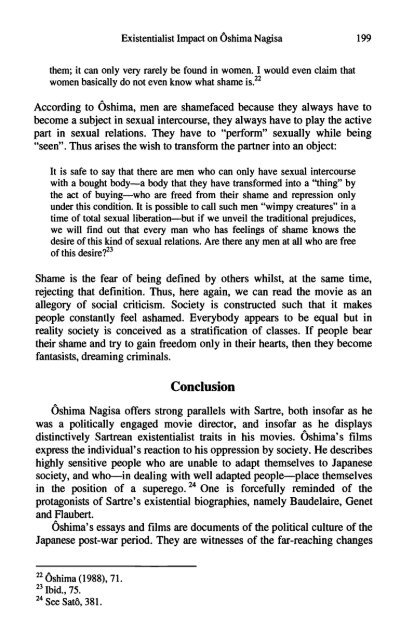Sartre's second century
Sartre's second century
Sartre's second century
Create successful ePaper yourself
Turn your PDF publications into a flip-book with our unique Google optimized e-Paper software.
Existentialist Impact on 6shima Nagisa 199<br />
them; it can only very rarely be found in women. I would even claim that<br />
women basically do not even know what shame is. 22<br />
According to Oshima, men are shamefaced because they always have to<br />
become a subject in sexual intercourse, they always have to play the active<br />
part in sexual relations. They have to "perform" sexually while being<br />
"seen". Thus arises the wish to transform the partner into an object:<br />
It is safe to say that there are men who can only have sexual intercourse<br />
with a bought body—a body that they have transformed into a "thing" by<br />
the act of buying—who are freed from their shame and repression only<br />
under this condition. It is possible to call such men "wimpy creatures" in a<br />
time of total sexual liberation—but if we unveil the traditional prejudices,<br />
we will find out that every man who has feelings of shame knows the<br />
desire of this kind of sexual relations. Are there any men at all who are free<br />
of this desire? 23<br />
Shame is the fear of being defined by others whilst, at the same time,<br />
rejecting that definition. Thus, here again, we can read the movie as an<br />
allegory of social criticism. Society is constructed such that it makes<br />
people constantly feel ashamed. Everybody appears to be equal but in<br />
reality society is conceived as a stratification of classes. If people bear<br />
their shame and try to gain freedom only in their hearts, then they become<br />
fantasists, dreaming criminals.<br />
Conclusion<br />
Oshima Nagisa offers strong parallels with Sartre, both insofar as he<br />
was a politically engaged movie director, and insofar as he displays<br />
distinctively Sartrean existentialist traits in his movies. Oshima's films<br />
express the individual's reaction to his oppression by society. He describes<br />
highly sensitive people who are unable to adapt themselves to Japanese<br />
society, and who—in dealing with well adapted people—place themselves<br />
in the position of a superego. 24 One is forcefully reminded of the<br />
protagonists of <strong>Sartre's</strong> existential biographies, namely Baudelaire, Genet<br />
and Flaubert.<br />
Oshima's essays and films are documents of the political culture of the<br />
Japanese post-war period. They are witnesses of the far-reaching changes<br />
22 Oshima (1988), 71.<br />
23 Ibid., 75.<br />
24 See Sato, 381.
















